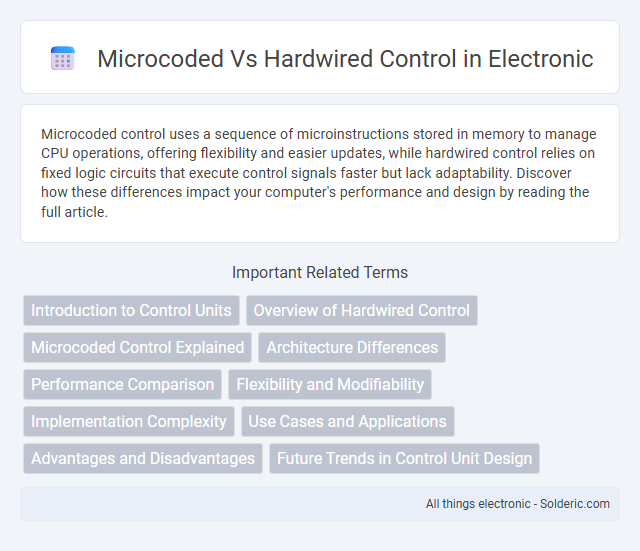Microcoded control uses a sequence of microinstructions stored in memory to manage CPU operations, offering flexibility and easier updates, while hardwired control relies on fixed logic circuits that execute control signals faster but lack adaptability. Discover how these differences impact your computer's performance and design by reading the full article.
Comparison Table
| Aspect | Microcoded Control | Hardwired Control |
|---|---|---|
| Design Complexity | Lower; uses microprogramming for control signals | Higher; fixed logic circuits design |
| Flexibility | Highly flexible; easy updates via microprogram changes | Rigid; changes require redesigning hardware |
| Control Speed | Slower due to sequential microinstruction execution | Faster due to direct combinational logic |
| Cost | Lower initial cost; uses memory for microinstructions | Higher cost; complex wiring and components |
| Implementation | Uses microprogram memory (ROM/RAM) | Uses combinational logic circuits |
| Control Unit Type | Microprogrammed Control Unit | Hardwired Control Unit |
| Modification | Simple; update microinstructions | Complicated; redesign hardware needed |
Introduction to Control Units
Control units in computer architecture direct the operation of the processor by generating control signals for data flow and instruction execution. Microcoded control units use a stored sequence of microinstructions, providing flexibility and easier modification, while hardwired control units rely on fixed logic circuits for faster control signal generation. The choice between microcoded and hardwired control impacts system complexity, speed, and adaptability in processor design.
Overview of Hardwired Control
Hardwired control uses fixed logic circuits to manage the sequence of operations within a CPU, providing faster execution due to its straightforward design. This control method is implemented through combinational logic, enabling rapid instruction decoding and control signal generation without the overhead of microinstruction interpretation. Your system benefits from reduced complexity and increased speed, though at the cost of flexibility compared to microcoded control units.
Microcoded Control Explained
Microcoded control uses a sequence of microinstructions stored in memory to manage the control signals of a processor, allowing for flexibility and easier updates compared to hardwired control. Each microinstruction specifies a set of operations in a control memory, enabling complex instruction execution through programmable steps rather than fixed hardware circuits. Your system benefits from microcoded control by supporting simpler design modifications and improved debugging, essential for evolving processor architectures.
Architecture Differences
Microcoded control architecture relies on a control memory unit storing microinstructions that generate control signals sequentially, allowing flexibility and easier modification of control logic. Hardwired control architecture uses fixed combinational circuits and sequential logic to produce control signals directly from the instruction opcode, resulting in faster execution but limited adaptability. Microcoded designs separate control logic from datapath hardware, while hardwired designs integrate control and datapath closely for optimized speed.
Performance Comparison
Microcoded control units typically offer greater flexibility but tend to have slower performance due to multiple clock cycles required for instruction execution. Hardwired control is optimized for speed, providing faster instruction execution by using dedicated control signals within a single clock cycle. Your choice between microcoded and hardwired control impacts the trade-off between performance efficiency and adaptability in processor design.
Flexibility and Modifiability
Microcoded control units offer greater flexibility and modifiability by storing control signals in firmware, enabling easier updates and customization without altering hardware. Hardwired control units are less adaptable due to fixed logic circuits, making changes complex and time-consuming, often requiring physical redesign. This makes microcoded designs preferable for systems that need frequent updates or complex instruction sets.
Implementation Complexity
Microcoded control units exhibit lower implementation complexity by using a set of stored microinstructions to direct processor operations, allowing easier modification and debugging. Hardwired control units rely on fixed combinational logic circuits, making their design more complex and less flexible when implementing control signals. Your choice depends on balancing simplicity against speed and customization requirements in hardware architecture.
Use Cases and Applications
Microcoded control is widely used in complex instruction set computing (CISC) architectures, enabling flexible and easily updatable instruction sets ideal for general-purpose processors and devices requiring frequent firmware updates. Hardwired control excels in applications demanding high-speed execution and low latency, such as embedded systems and digital signal processors, where deterministic performance and minimal control unit delay are critical. Embedded microcontrollers in automotive systems often favor hardwired control for reliability and speed, while microcoded control suits versatile computing platforms like personal computers and server CPUs.
Advantages and Disadvantages
Microcoded control offers greater flexibility by enabling easy updates and complex instruction sets through software changes, which simplifies debugging and design modifications. Hardwired control provides faster execution speeds and more efficient hardware utilization by directly implementing control signals in logic circuits, resulting in higher performance for simple, fixed instruction sets. However, hardwired control lacks adaptability and is more difficult to modify or debug compared to the microcoded approach, which can suffer from slower instruction cycle times due to its sequential nature.
Future Trends in Control Unit Design
Future trends in control unit design emphasize increased adaptability and efficiency, with microcoded control units gaining prominence due to their flexibility in updating instruction sets and ease of debugging. Hardwired control units, while faster for fixed instruction sets, face limitations in scalability and modification, making them less suitable for evolving processor architectures. Your system can benefit from hybrid designs that combine the speed of hardwired control with the versatility of microcoding to meet future computing demands.
microcoded vs hardwired control Infographic

 solderic.com
solderic.com